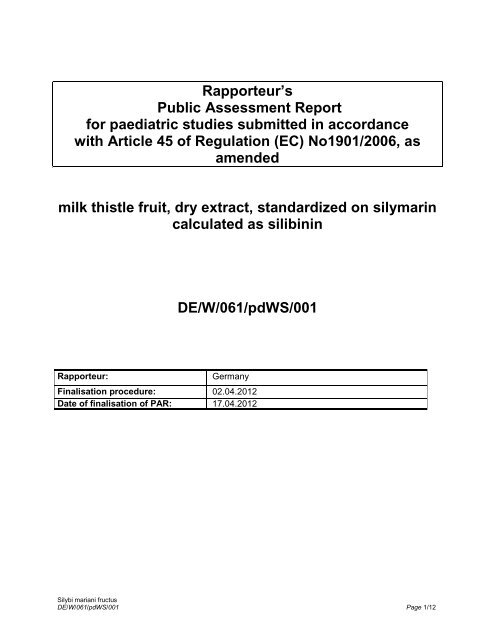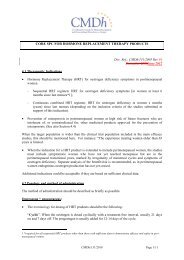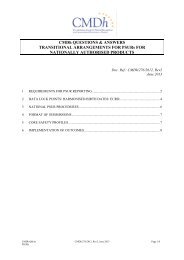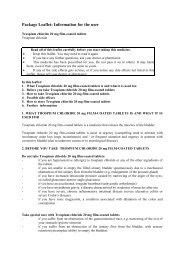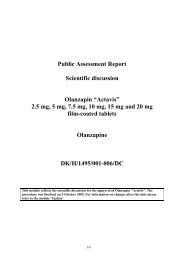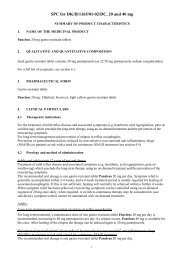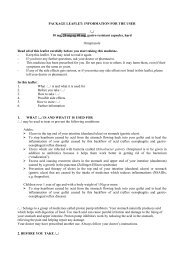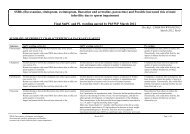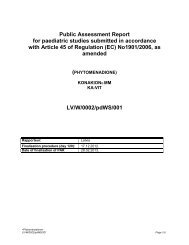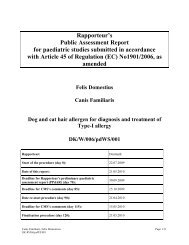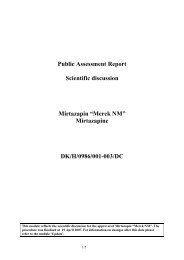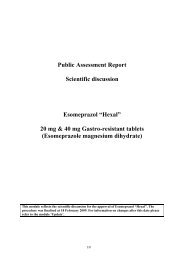Silybi mariani fructus - Heads of Medicines Agencies
Silybi mariani fructus - Heads of Medicines Agencies
Silybi mariani fructus - Heads of Medicines Agencies
You also want an ePaper? Increase the reach of your titles
YUMPU automatically turns print PDFs into web optimized ePapers that Google loves.
Rapporteur’s<br />
Public Assessment Report<br />
for paediatric studies submitted in accordance<br />
with Article 45 <strong>of</strong> Regulation (EC) No1901/2006, as<br />
amended<br />
milk thistle fruit, dry extract, standardized on silymarin<br />
calculated as silibinin<br />
DE/W/061/pdWS/001<br />
Rapporteur: Germany<br />
Finalisation procedure: 02.04.2012<br />
Date <strong>of</strong> finalisation <strong>of</strong> PAR: 17.04.2012<br />
<strong>Silybi</strong> <strong>mariani</strong> <strong>fructus</strong><br />
DE/W/061/pdWS/001 Page 1/12
ADMINISTRATIVE INFORMATION<br />
Invented name <strong>of</strong> the medicinal<br />
product(s):<br />
INN (or common name) <strong>of</strong> the active<br />
substance(s):<br />
See section VI<br />
<strong>Silybi</strong> <strong>mariani</strong> <strong>fructus</strong><br />
MAH (s): See section VI<br />
Pharmaco-therapeutic group<br />
(ATC Code):<br />
Pharmaceutical form(s) and<br />
strength(s):<br />
milk thistle fruit, dry extract, standardized on<br />
silymarin calculated as silibinin<br />
A05BA03<br />
different galenic formulations<br />
<strong>Silybi</strong> <strong>mariani</strong> <strong>fructus</strong><br />
DE/W/061/pdWS/001 Page 2/12
TABLE OF CONTENTS<br />
I. Executive Summary ....................................................................................................... 4<br />
II. RecommendatioN .......................................................................................................... 5<br />
III. INTRODUCTION ............................................................................................................. 5<br />
IV. SCIENTIFIC DISCUSSION .............................................................................................. 6<br />
IV.1 Information on the pharmaceutical formulation used in the clinical study(ies) ......... 6<br />
IV.2 Non-clinical aspects ................................................................................................................... 6<br />
IV.3 Clinical aspects ............................................................................................................................ 6<br />
V. Rapporteur’s Overall Conclusion AND RECOMMENDATION ................................... 11<br />
VI. List <strong>of</strong> Medicincal products and marketing authorisation holders involved ........... 12<br />
<strong>Silybi</strong> <strong>mariani</strong> <strong>fructus</strong><br />
DE/W/061/pdWS/001 Page 3/12
I. EXECUTIVE SUMMARY<br />
No SmPC and PL changes are proposed.<br />
Summary <strong>of</strong> outcome<br />
x No change<br />
Change<br />
New study data: <br />
<strong>Silybi</strong> <strong>mariani</strong> <strong>fructus</strong><br />
DE/W/061/pdWS/001 Page 4/12
II. RECOMMENDATION<br />
No further action required<br />
III. INTRODUCTION<br />
The active substance <strong>of</strong> the herbal medicinal product is a dry extract <strong>of</strong> milk thistle fruit,<br />
standardized on silymarin calculated as silibinin. This milk thistle dry extract is authorized in a lot<br />
<strong>of</strong> European and non-European countries. The amount <strong>of</strong> silymarin per dosage unit differs<br />
because <strong>of</strong> different galenic formulations. The most common one is a capsule containing 140<br />
mg silymarin. Silymarins values given have been analyzed by UV-photometric method and not<br />
by the newer HPLC method (if not otherwise stated).<br />
Standardized dry extract <strong>of</strong> milk thistle fruit is used for “toxic liver damage, and also for the<br />
supportive treatment <strong>of</strong> chronic inflammatory liver diseases and hepatic cirrhosis” mainly in<br />
adults and based on bibliographic data and experts’ opinions like the German Commission E.<br />
A reevaluation <strong>of</strong> the bibliographic data for this herbal preparation and a preparation <strong>of</strong> a<br />
monograph are planned by the Committee on Herbal Medicinal Products (HMPC) <strong>of</strong> the<br />
European <strong>Medicines</strong> Agency (EMA).<br />
In former times the German marketing authorisations were granted for adolescents above 12<br />
years <strong>of</strong> age and adults. Recent German marketing authorisations only cover adults because no<br />
sufficient data were available for the paediatric population and the indications were not typical<br />
for this population.<br />
Two publications on the use <strong>of</strong> milk thistle, dry extract, standardized on silymarin in paediatrics<br />
in accordance with Article 45 <strong>of</strong> the Regulation (EC)No 1901/2006 <strong>of</strong> the European Parliament<br />
and <strong>of</strong> the Council on medicinal products for paediatric use were submitted. None original study<br />
data were submitted.<br />
A short critical expert overview has also been provided.<br />
It was stated that the submitted paediatric data do not influence the benefit risk assessment for<br />
milk thistle, dry extract, standardized on silymarin. These data would show that milk thistle, dry<br />
extract, standardized on silymarin is an effective and safe treatment in children.<br />
It was proposed the following regulatory action:<br />
Amendment <strong>of</strong> the dosage recommendations as follows:<br />
Children from 6 to 12 years <strong>of</strong> age: milk thistle fruit, dry extract equivalent to 70 mg silymarin tid.<br />
Adolescent from 12 to 18 years <strong>of</strong> age: milk thistle fruit, dry extract equivalent to 140 mg<br />
silymarin bid.<br />
As reponse to the rapporteur’s preliminary assessment report, an additional more recent<br />
publication (Ladas et al. 2010) was submitted. It was stated that the dosage <strong>of</strong> silibinin<br />
administered in this trial could not directly support the proposed dosage recommended for<br />
children, as it was considerably higher, but it could be proven again that a therapy with milk<br />
thistle, dry extract, standardized on silymarin is safe also in children.<br />
<strong>Silybi</strong> <strong>mariani</strong> <strong>fructus</strong><br />
DE/W/061/pdWS/001 Page 5/12
IV. SCIENTIFIC DISCUSSION<br />
IV.1 Information on the pharmaceutical formulation used in the clinical study(ies)<br />
Jodl et al. 1983 used Legalon® in their clinical study as coated tablets, liquid preparation, and in<br />
a small number <strong>of</strong> patients as injection. The exact specification <strong>of</strong> these herbal preparations are<br />
not mentioned.<br />
Musso et al 1980 used Legalon syrup, provided by the Italian Biochemical Institute; no exact<br />
specification is given.<br />
Ladas et al. 2010 used Siliphos (Thorne Research, Sandpoint, ID), for which different<br />
specifications are given. On the one hand it is described as an 1:2 mixture <strong>of</strong> silibinin and soy<br />
phosphatidylcholine. Silibinin is a mixture <strong>of</strong> 2 diastereoisomeric compounds, <strong>Silybi</strong>n A and B.<br />
On the other hand it is stated that each capsule contains 240 mg milk thistle, standardized to 80<br />
mg <strong>of</strong> silibinin (<strong>Silybi</strong>n A and B). Additionally it was explained that with Legalon, the silibinin<br />
content is about half <strong>of</strong> the total weight <strong>of</strong> Silymarin (determined by HPLC, Ph.Eur.method).<br />
Therefore the corresponding amounts <strong>of</strong> milk thistle, dry extract, standardized on silymarin (in<br />
terms <strong>of</strong> Silymarin) had to be ca. twice as high as silibinin administered in the Ladas study.<br />
IV.2 Non-clinical aspects<br />
1. Introduction<br />
Non-clinical data were not provided as regards to this Article 45 Procedure.<br />
2. Non clinical study(ies)<br />
Not applicable<br />
3. Discussion on non clinical aspects and conclusion<br />
Not applicable<br />
IV.3 Clinical aspects<br />
1. Introduction<br />
Two publications and their English translation were submitted:<br />
- Jodl J, Havlovicová L, Kasal P, Singer L. Therapeutische Möglichkeiten mit Legalon® in<br />
der Pädiatrie (Therapeutic uses <strong>of</strong> Legalon® in paediatrics). Medica Clinica 1983, 4, No.<br />
11;<br />
- Musso A, Giacchino M, Vietti M, Vaccino P, Cerutti A. Considerazioni sull’uso della<br />
Silimarina e della SAMe nel trattamento dell’epatite infettiva acuta dell’infanzia (Remarks<br />
<strong>Silybi</strong> <strong>mariani</strong> <strong>fructus</strong><br />
DE/W/061/pdWS/001 Page 6/12
on the use <strong>of</strong> silymarin and SAMe in the treatment <strong>of</strong> acute infectious hepatitis in<br />
infancy). Min. Ped. 32, 1980: 1057-1067;<br />
As reponse to the PPdAR one more publication was submitted:<br />
- Ladas EJ, Kroll DJ, Oberlies NH, Cheng B, Ndao DH, Rheingold SR, Kelly KM. A<br />
Randomized, Controlled, Double-Blind, Pilot Study <strong>of</strong> Milk thistle for the Treatment <strong>of</strong><br />
Hepatotoxicity in Childhood Acute Lymphoblastic Leukemia (ALL). Cancer 2010; 116:<br />
506-513<br />
2. Clinical data<br />
Jodl et al. 1983<br />
In this clinical investigation the therapeutic effect <strong>of</strong> Legalon was evaluated in 166 patients with<br />
chronic liver diseases aged from 0 to 17 years. The dose <strong>of</strong> Legalon was adapted to the<br />
patient’s age.<br />
age <strong>of</strong> years number <strong>of</strong> patients average doses <strong>of</strong> milk thistle dry extract<br />
standardized on silymarin in mg (silymarin)/24<br />
hours (liquid, coated tablets)<br />
0 - 2 28 105<br />
3 - 7 25 210<br />
8 - 12 80 315<br />
13 - 17 33 420<br />
In a small number <strong>of</strong> infants Legalon was given by injection.<br />
In the majority <strong>of</strong> patients dietary measures, bed rest, vitamin therapy and Legalon were the sole<br />
modes <strong>of</strong> treatment.<br />
Subdivision <strong>of</strong> patients according to diagnosis was as follows:<br />
Posthepatic syndrome 25 n<br />
Chronic persistent hepatitis 47 n<br />
Chronic active hepatitis 59 n<br />
Toxic-metabolic liver damage (acquired or congenital) 35 n<br />
Whereas in the school and preschool children the main diagnosis were subacute hepatitis and<br />
chronic persistent hepatitis, in the newborn and very young ones it was liver damage caused by<br />
various forms <strong>of</strong> malabsorption syndrome.<br />
Endpoints were patients’ subjective complaints and objective clinical findings at the regular<br />
ambulant follow-ups at six to eight weeks. Routine laboratory investigation included serum<br />
bilirubin, alkaline phosphatase activity, transaminases, the thymol turbidity test, serum protein<br />
electrophoresis, prothrombin time and testing for Australia antigen (HBsAG). In some patients<br />
LDH, cholinesterase and y-GT were measured additionally.<br />
In the group <strong>of</strong> patients with subacute hepatitis Legalon was given for 10 to 12 weeks. A<br />
beneficial effect in form <strong>of</strong> regression <strong>of</strong> clinical and biochemical findings was noted after five<br />
weeks’ treatment.<br />
In the group <strong>of</strong> patients with chronic persistent hepatitis 50 % <strong>of</strong> the patients were HBsAg<br />
positive. The average duration <strong>of</strong> Legalon treatment was four months. At the end <strong>of</strong> treatment all<br />
subjective complaints (tiredness, loss <strong>of</strong> appetite, abdominal distension by gas, abdominal pain)<br />
<strong>Silybi</strong> <strong>mariani</strong> <strong>fructus</strong><br />
DE/W/061/pdWS/001 Page 7/12
had completely disappeared or considerably improved. Clinical and laboratory findings returned<br />
to normal in 70 % <strong>of</strong> patients. In 26 % <strong>of</strong> the patients hepatomegaly or raised enzyme levels<br />
persisted, but subjective symptoms disappeared. The disease recrudesced in two children within<br />
three months after discontinuation <strong>of</strong> the treatment with Legalon.<br />
In 14 patients <strong>of</strong> this group immunoglobulin levels were examined before Legalon treatment and<br />
again six weeks afterwards and showed an increase in all immunoglobulin-fractions (Fig.2 is not<br />
readable). 4 % showed no improvement or stabilization.<br />
In patients with chronic active hepatitis 65 % <strong>of</strong> the patients were HBsAg positive. The average<br />
duration <strong>of</strong> Legalon treatment was ten months. in two-thirds <strong>of</strong> the patients Legalon was given<br />
after previous unsuccessful therapy with a combination <strong>of</strong> corticosteroids and vitamins or<br />
corticosteroids and immunosuppressives. In 32 % <strong>of</strong> patients definitive improvement could<br />
achieved, however abnormalities <strong>of</strong> serum proteins persisted. Stabilisation <strong>of</strong> the disease could<br />
be achieved in 44 % and no improvement or stabilisation in 24 %.<br />
In patients with toxic-metabolic liver damage Legalon was given for four to eight weeks by all<br />
modes <strong>of</strong> administration including intravenous route. According to the authors the percentage <strong>of</strong><br />
positive therapeutic responses is very difficult to assess because this group <strong>of</strong> patients is<br />
diagnostically very heterogeneous.<br />
In none <strong>of</strong> the patients any individual intolerance towards the drug, or any other side effects<br />
which require the discontinuation <strong>of</strong> the treatment with Legalon, were observed.<br />
Assessor’s comment:<br />
Only the publication is submitted. Detailed information is missing. The used medicinal products<br />
are not specified sufficiently. It is unclear, if the indicated dose refers to silymarin or the herbal<br />
preparation. Different mode <strong>of</strong> applications, different indications are mixed up. The inclusion and<br />
exclusion criteria, the endpoints and test measures are not clearly defined.<br />
The number <strong>of</strong> patients in the different age groups is small. Comedication is unclear.<br />
The design <strong>of</strong> the investigation e.g. whether it is an uncontrolled or a controlled one, a blinded or<br />
non-blinded one, is unclear.<br />
No objective conclusions on efficacy can be drawn based on this publication. Tolerance seems<br />
to be good, but the number <strong>of</strong> treated patients is very small.<br />
Musso et al. 1980<br />
17 children (age between 5 and 12 years) with acute HBsAg negative virale hepatitis were<br />
examined in this clinical investigation. Ten children were treated with silymarin 12 mg/kg/day<br />
(Legalon syrup, provided by the Italian Biochemical Institute; no exact specification is given)<br />
alone, and seven with a combination <strong>of</strong> silymarin 12 mg/kg/day and SAMe (S-Adenosil-Lmethionone)<br />
5 mg/kg/day.<br />
The following parameters were studied: glutamic oxaloacetic transaminase (GOT), glutamic<br />
pyruvic transaminase (GPT), bilirubin, alkaline phosphatise, lactate dehydrogenase (LDH),<br />
cholinesterase, and gamma-glutamyl transpeptidase (Gamma GT).<br />
Results<br />
GOT: day 10: mean decrease <strong>of</strong> 50 % from the original values<br />
day 30: normalization in 9 <strong>of</strong> 10 subjects treated with silymarin alone and<br />
in 5 <strong>of</strong> 7 subjects treated with the combination.<br />
<strong>Silybi</strong> <strong>mariani</strong> <strong>fructus</strong><br />
DE/W/061/pdWS/001 Page 8/12
GPT: day 10: mean decrease <strong>of</strong> 50 % from the original values<br />
day 30: normalization in 8 <strong>of</strong> 10 subjects treated with silymarin alone and<br />
in 5 <strong>of</strong> 7 subjects treated with the combination.<br />
Bilirubin: day 10: mean decrease <strong>of</strong> around 50 % from the original values<br />
day 20: normalization in all cases<br />
LDH: day 20: normalization in 8 <strong>of</strong> 9 subjects treated with silymarin alone while<br />
the trend was less clear in cases treated with the combination<br />
Alkaline phosphatase: day 20: normalization in 16 <strong>of</strong> 17 cases without significant difference<br />
between the two treatment.<br />
According to the authors gamma GT and cholinesterase also normalized. However, according to<br />
the provided tables, cholinesterase was only elevated in one patient at baseline.<br />
Comparison <strong>of</strong> the means <strong>of</strong> the differences in the two groups using T test for independent data<br />
was not statistically significant for any <strong>of</strong> the parameters in consideration.<br />
Assessor’s comment:<br />
Only the publication is submitted. Detailed information is missing. The used medicinal product is<br />
not specified sufficiently. The inclusion and exclusion criteria, the endpoints and test measures<br />
are not clearly defined.<br />
The number <strong>of</strong> patients is small. Comedication is not mentioned.<br />
The design <strong>of</strong> the investigation e.g. whether it is a blinded or non-blinded one, is unclear.<br />
No objective conclusions on efficacy can be drawn based on this publication . Information <strong>of</strong><br />
safety/tolerance is missing.<br />
The authors themselves indicate that a definitive opinion is impossible as they do not have a<br />
caseload <strong>of</strong> untreated hepatitis patients <strong>of</strong> the same age for comparison.<br />
Acute viral hepatitis is not an authorised indication for milk thistle fruit preparation standardized<br />
to silymarin, at least in the RMS, and therefore this is an <strong>of</strong>f-label-use.<br />
Ladas et al. 2010<br />
In this randomized, controlled, double-blind pilot study 50 children (age range from 1.7 to 18.9<br />
years) with acute lymphoblastic leukemia (ALL) and hepatic toxicity were enrolled and orally<br />
received either 5.1 mg/kg bodyweight/day silibinin (Siliphos) (24 children) or placebo (26<br />
children) for 28 days in addition to the chemotherapy. 49 children were evaluable. One child<br />
refused to take any dose <strong>of</strong> verum and was excluded from the study analysis.<br />
Treatment started the day after administration <strong>of</strong> intravenous chemotherapy. Hepatoxicity was<br />
measured at day 0, day 28, and day 56.<br />
No significant differences between verum and placebo in aspartate amino transferase<br />
(AST/GOT) or amino alanine transferase (ALT/GPT) from baseline to day 28 (p= .55; p=. 50,<br />
respectively) were observed. At day 56, the verum group had a significantly lower AST (p= .05)<br />
and a trend toward a significantly lower ALT (p= .07) from baseline than the placebo group. No<br />
significant differences was observed in mean total bilirubin. No significant differences in doses <strong>of</strong><br />
chemotherapy administered, reductions <strong>of</strong> chemotherapy doses, or delays in treatment, in the<br />
number or severity <strong>of</strong> toxicities or rates <strong>of</strong> infection between the 2 groups were observed.<br />
The patient-reported side effects were mild and were pre-existing complaints before the initiation<br />
<strong>of</strong> study treatment. No significant differences in patient reported side effects were found between<br />
the 2 groups.<br />
<strong>Silybi</strong> <strong>mariani</strong> <strong>fructus</strong><br />
DE/W/061/pdWS/001 Page 9/12
Plasma silibinin levels were analyzed in 18 patients (9 patients in each group). Although limit <strong>of</strong><br />
detection was at least 10-fold below the concentration reported in publications, detectable levels<br />
<strong>of</strong> silibinin compounds were not observed in any <strong>of</strong> the plasma samples from our study patients.<br />
Assessor’s comment:<br />
Only the publication is submitted. This study is a pilot study. Therefore the results have to be<br />
confirmed by further studies. This is also recommended by the authors.<br />
The used medicinal product is not specified sufficiently and consistently, but it is clear that it is a<br />
combination <strong>of</strong> two compounds. Whether one compound is purified silibinin or an unknown milk<br />
thistle preparation standardized on silibinin is unclear. However the milk thistle preparation used<br />
in Legalon is not comparable to this product. The other compound soy phosphatidylcholine is<br />
also used in toxic liver damage and chronic hepatitis. Therefore possible effects cannot be<br />
attributed to silibinin alone.<br />
The study population is a very special one. The number <strong>of</strong> patients is small. The number <strong>of</strong><br />
treated patients is missing for the different age groups. The administered dosages <strong>of</strong> silibinin do<br />
not correspond to the milk thistle dry extract (standardized on Silymarin) dosages proposed for<br />
children. The administered dosages were considerably higher.<br />
According to the authors preclinical data demonstrate that verum does not comprise the<br />
anticancer activity <strong>of</strong> L-asparaginase or vincristine in CCRF-CEM cell lines (human t cell<br />
lymphoblast-like cell lines). However, clinical data are missing.<br />
Efficacy<br />
3. Discussion on clinical aspects and conclusion<br />
The used herbal preparation is not exactly specified.<br />
The first two publications cannot justify a dosage recommendation for children from 6 to 12<br />
years <strong>of</strong> age and for adolescents from 12 to 18 years <strong>of</strong> age.<br />
These investigations were carried out nearly 20 years ago. Important and essential information<br />
are missing in the publications (see above). The patients’ collective is inhomogeneous and<br />
small. The study designs seem to be inadequate to prove efficacy.<br />
The use in acute viral hepatitis is an <strong>of</strong>f-label use in the RMS.<br />
It was not reflected the actual state <strong>of</strong> knowledge concerning hepatic disease especially viral<br />
hepatitis. Since 1980 medicinal knowledge has increased; for example not until 1989 the<br />
existence <strong>of</strong> hepatitis C was proven; antiviral therapy or treatment with immune system<br />
modulators like interferon have been established.<br />
Also the third provided publication cannot justify a dosage recommendation for children and<br />
adolescents. This study was only a pilot study in a very special study population and has to be<br />
confirmed by further studies. The proven product is not specified exactly; therefore the<br />
comparability to a herbal preparation with milk thistle, dry extract, standardized on silymarin<br />
remains unclear. The proven product dosage is not comparable to the proposed dosage for<br />
children for milk thistle, dry extract, standardized on silymarin.<br />
<strong>Silybi</strong> <strong>mariani</strong> <strong>fructus</strong><br />
DE/W/061/pdWS/001 Page 10/12
The RMS cannot endorse the conclusion that milk thistle, dry extract, standardized on silymarin<br />
is an effective treatment in children and adolescents.<br />
Safety<br />
In the investigation <strong>of</strong> Jodl et al. 1983 no adverse event was observed, however the number <strong>of</strong><br />
treated patients in the different age groups was small.<br />
According to provided pharmacovigilance data only 2 cases <strong>of</strong> adverse drug effects in children<br />
were spontaneously reported for milk thistle, dry extract, standardized on silymarin during July<br />
2008 to June 2011, together with 5 case reports <strong>of</strong> overdosing or <strong>of</strong>f label use without adverse<br />
reactions in this population.<br />
In 4 countries in the world (Brazil, Italy, Portugal and Korea) special formulations for the use in<br />
children are available (different liquid forms like suspension, syrup etc.). It was assumed that a<br />
high amount <strong>of</strong> the estimated number <strong>of</strong> patients treated with these liquid formulations (584,321<br />
patients during the above mentioned period) were children.<br />
The RMS cannot endorse this conclusion that these data show that such a therapy is connected<br />
without any risks for children and adolescents.<br />
The number <strong>of</strong> treated children is based on an estimation without evidence.<br />
An underreporting <strong>of</strong> spontaneous adverse drug effects is well known.<br />
Although in the actually provided third publication the patient-reported side effects were mild and<br />
pre-existing complaints before the initiation <strong>of</strong> the study, these data are insufficient to show that<br />
the proposed dosage recommendation <strong>of</strong> milk thistle, dry extract, standardized on silymarin for<br />
children and adolescents is safe. The tested product is not comparable with milk thistle, dry<br />
extract, standardized on silymarin. Milk thistle, dry extract, standardized on silymarin is a<br />
multicomponent mixture like all herbal preparations, even if it is a standardized extract.<br />
Therefore all compounds can influence the safety. A risk assessment cannot be based on<br />
silymarin or silibinin, only. Data <strong>of</strong> herbal preparations comparable with milk thistle, dry extract,<br />
standardized on silymarin are needed.<br />
In addition the study population is too small for a valid safety evaluation.<br />
V. RAPPORTEUR’S OVERALL CONCLUSION AND<br />
RECOMMENDATION<br />
Overall conclusion<br />
On the conclusion that the submitted data would show that milk thistle, dry extract, standardized<br />
on silymarin is an effective and safe treatment it was proposed the following regulatory action:<br />
Amendment <strong>of</strong> the dosage recommendations as follows:<br />
Children from 6 to 12 years <strong>of</strong> age: milk thistle fruit, dry extract equivalent to 70 mg silymarin tid.<br />
Adolescent from 12 to 18 years <strong>of</strong> age: milk thistle fruit, dry extract equivalent to 140 mg<br />
silymarin bid.<br />
Based on the data submitted for milk thistle, dry extract, standardized on silymarin, the RMS<br />
concludes that the data are insufficient to endorse these recommendations, even if more<br />
detailed information <strong>of</strong> the investigations are provided.<br />
<strong>Silybi</strong> <strong>mariani</strong> <strong>fructus</strong><br />
DE/W/061/pdWS/001 Page 11/12
.<br />
Neither the efficacy nor the safety in the paediatric population are established.<br />
The actually provided publication does not modify this conclusion.<br />
No further comments were sent by the CMS. Therefore the procedure is finalized without any<br />
modification.<br />
Recommendation<br />
No further action required<br />
VI. LIST OF MEDICINCAL PRODUCTS AND MARKETING<br />
AUTHORISATION HOLDERS INVOLVED<br />
MAH<br />
Madaus<br />
GmbH<br />
Name <strong>of</strong><br />
the<br />
medicinal<br />
product<br />
Legalon®<br />
Pharmaceutical<br />
form<br />
different galenic<br />
formulations<br />
Active substance<br />
milk thistle fruit, dry extract,<br />
standardized on silymarin calculated<br />
as silibinin<br />
<strong>Silybi</strong> <strong>mariani</strong> <strong>fructus</strong><br />
DE/W/061/pdWS/001 Page 12/12


